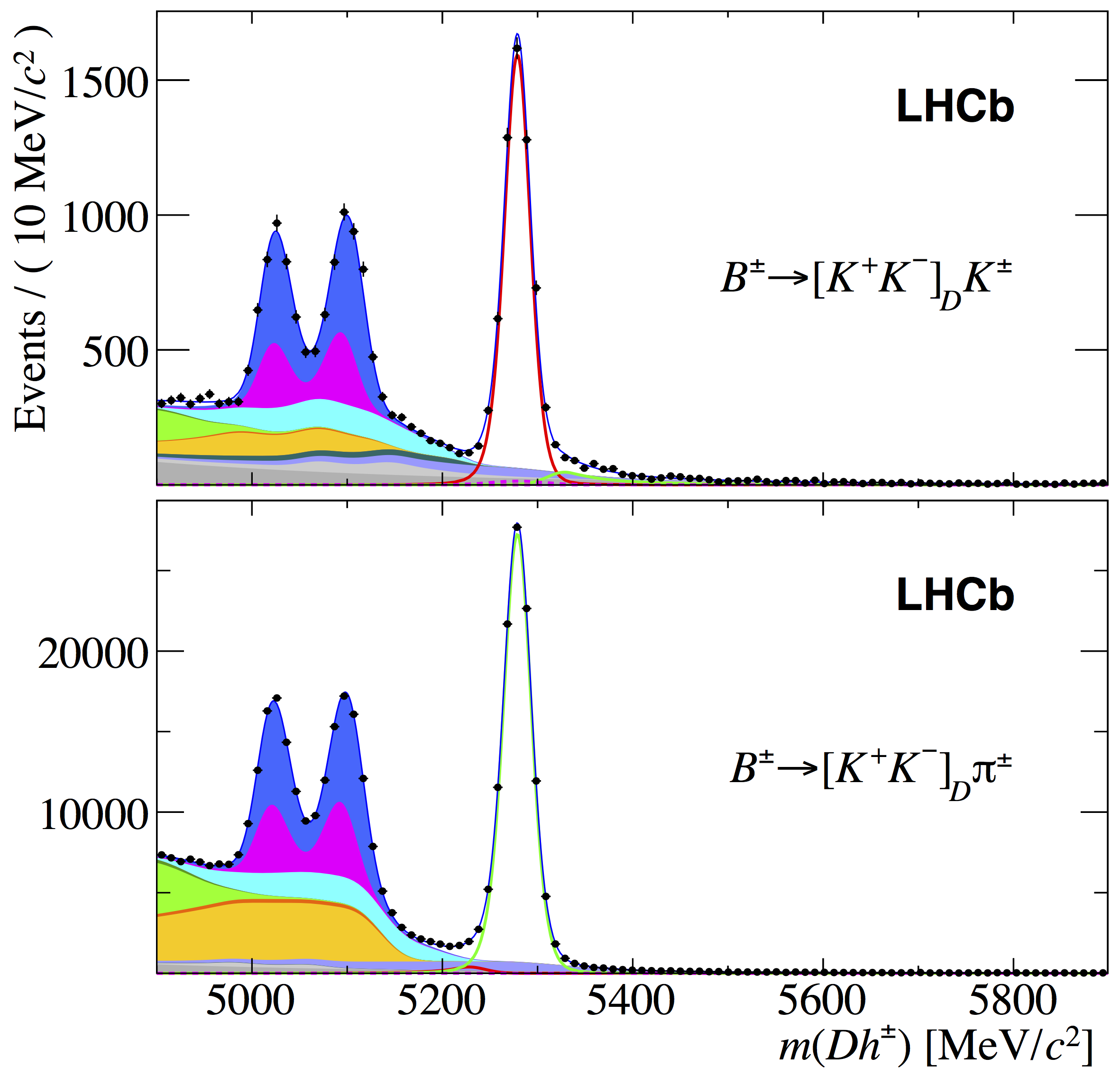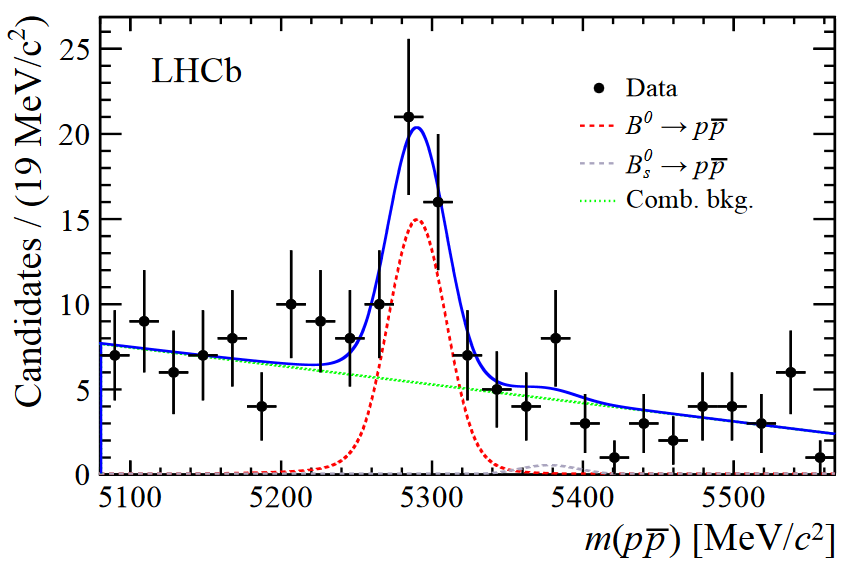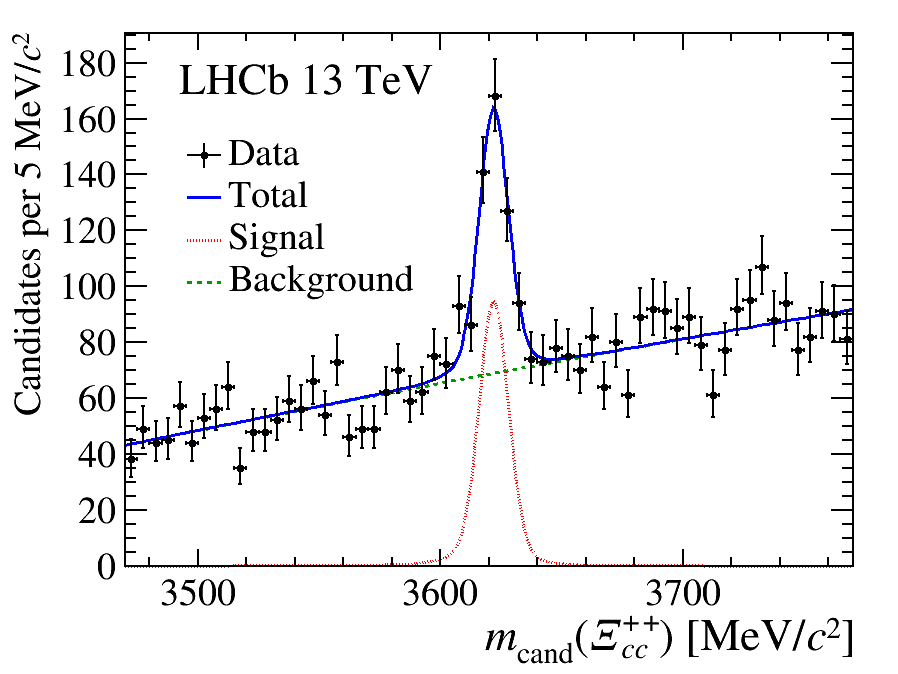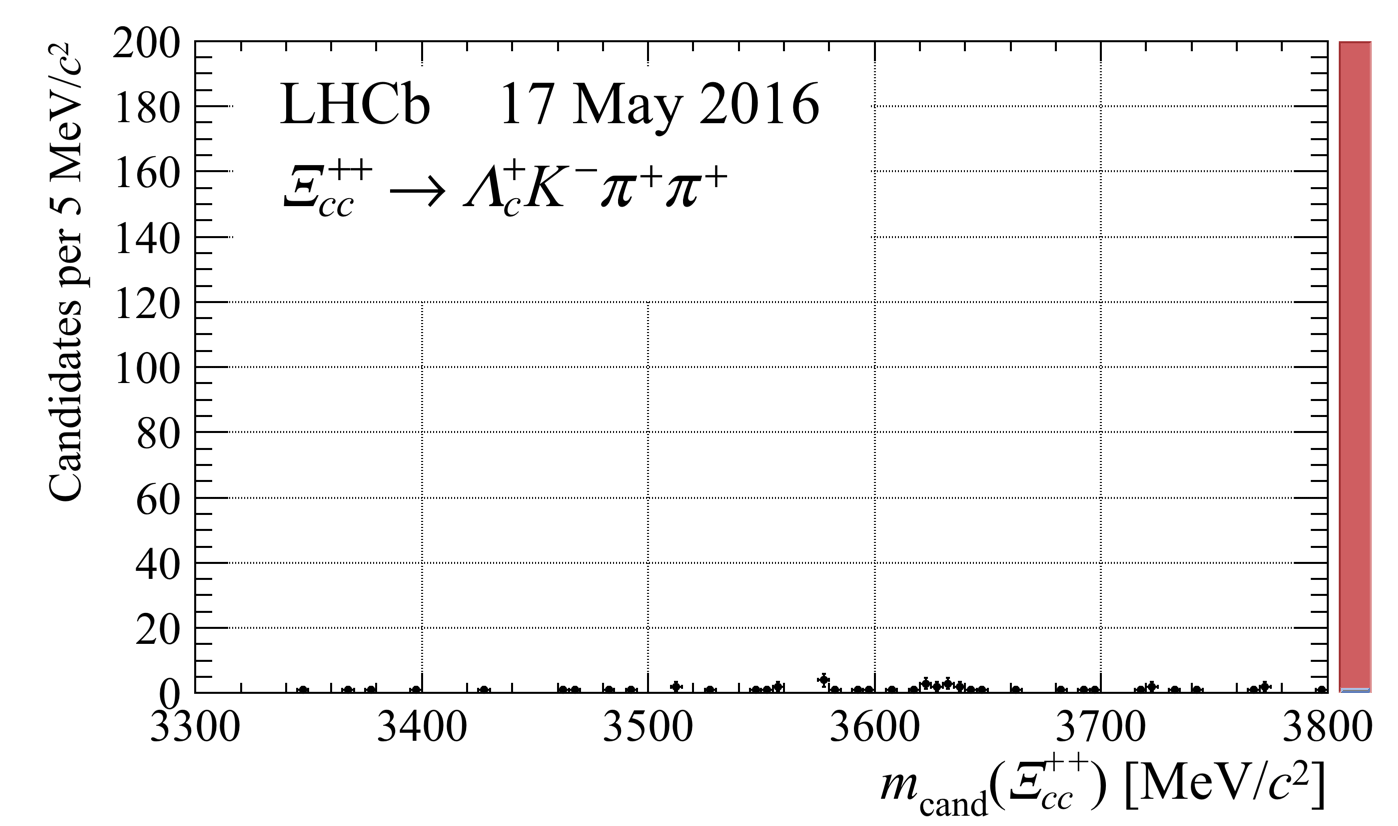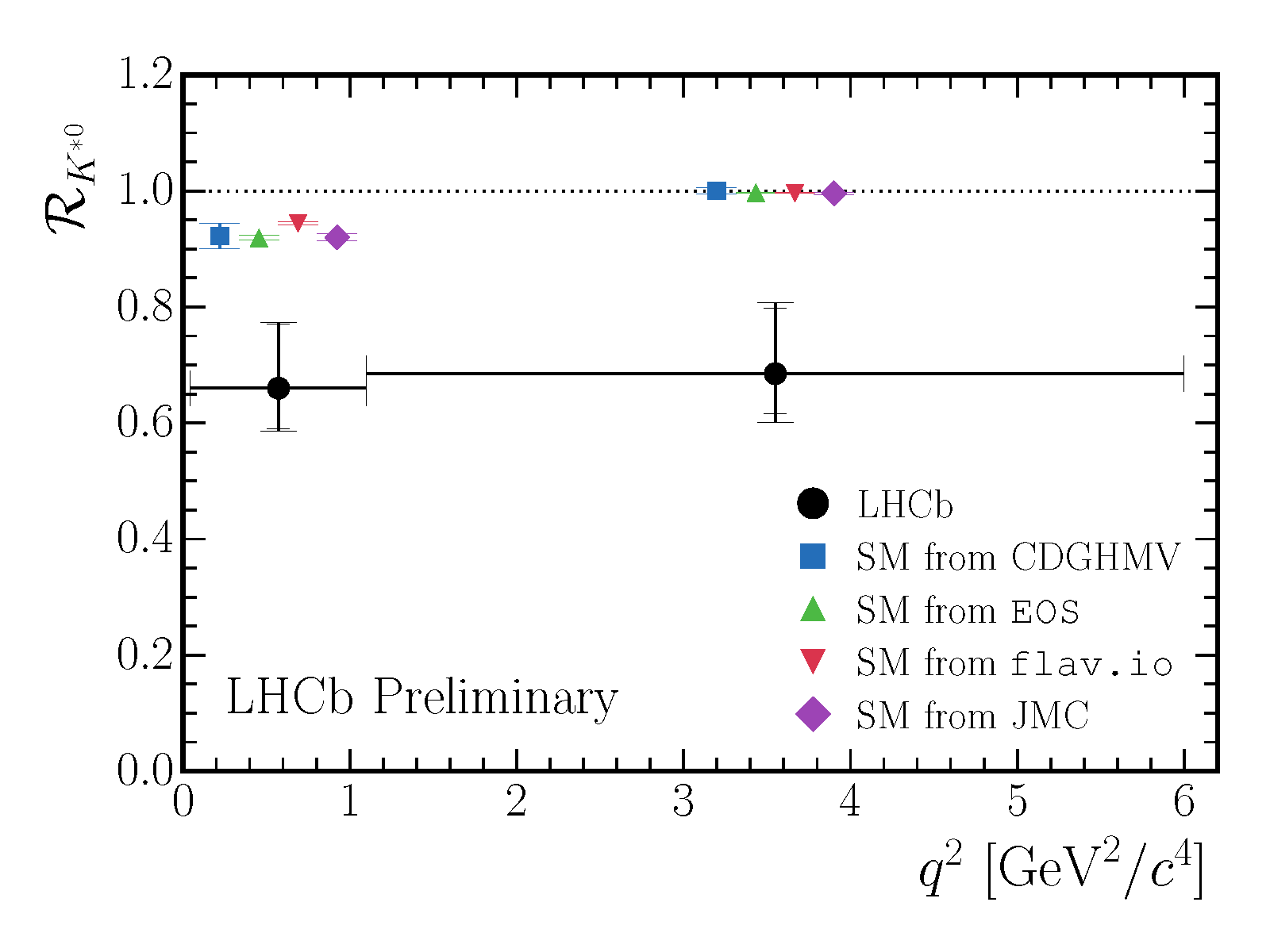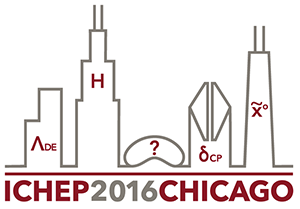LHCb makes a splash in Venice
14 July 2017
The LHCb collaboration has released a host of new results at the EPS-HEPP conference in Venice this week. The conference is a biennial meeting of the high energy physics community, typically attracting around 1000 participants to discuss all aspects of the world-wide particle physics programme.
One highlight was the announcement of the discovery of the doubly-charmed Ξcc++ baryon (see the news item of 6 July) but many others were reported by a total of 32 speakers from LHCb covering a broad range of topics, including CP violation, rare b-hadron decays and heavy-ion physics. In particular, the collaboration announced an updated measurement of the CKM angle γ from a combination of results from several analyses of B→DK and related decays. The measurement of γ is one of the main aims of the LHCb experiment and a standard candle test for the Standard Model (SM) due to its very precise theoretical prediction. The new result gives a value of γ of (76.8+5.1−5.7)°, which is the most precise measurement to date.
A crucial aspect of measuring γ is the need to combine information from many different decay modes, as there is no single channel that dominates the precision. The LHCb collaboration is ensuring that the full potential of the dataset is exploited by making use of as many different decay modes as possible. This is highlighted by a new measurement of B→D*K decays using a novel partial reconstruction technique in which the D* → Dπ0 and D* → Dγ decays can be separated without the need to reconstruct the neutral pion or photon. The method is illustrated in the top figure, with the partially reconstructed component clearly visible to the left of the large peak from B→DK decays. The B→D*K decays with D* → Dπ0 and D* → Dγ are shown as the dark blue double humped structure and the light blue broad shape, respectively; several background decays are also shown in different colours. Donal Hill from the University of Oxford, who led the analysis, said "This is a major breakthrough for LHCb. The fact that we can use partial reconstruction to measure B→D*K decays significantly increases the range of channels that can be studied and will help us to further reduce the uncertainty on γ."
Another exciting new result is the first observation of a B0 meson decaying to a proton and an anti-proton, shown in the bottom figure. Only about one in ten million B0 mesons decay in this way, making it the rarest decay mode of the B0 meson ever observed. Lars Eklund from the University of Glasgow, who worked on the analysis, said "The exquisite performance of the LHCb detector allows us to break new frontiers in sensitivity to rare decays. The ability to distinguish protons from other charged particles, provided by our ring-imaging Cherenkov counters, and the precise vertex information provided by the silicon vertex locator were both essential to this discovery."
The LHC has just resumed operations for 2017 and will continue until the end of 2018, allowing LHCb to approximately double its existing data sample. An upgraded LHCb detector will then be installed and will start collecting data in 2021, leading to significant further increases. The larger data samples that will be accumulated will enable even more precise measurements that will provide stringent tests of the Standard Model of particle physics.
Observation of the doubly heavy baryon Ξcc++
6 July 2017
The LHCb collaboration has announced the discovery of a new particle, the Ξcc++ state. Just like the protons that circulate in the Large Hadron Collider, the new particle is a baryon, composed of three quarks bound together by the strong force. However, unlike the proton which is made from three light quarks (two up quarks and a down quark), the Ξcc++ contains one up quark and two charm quarks. Since the charm quarks are much heavier than up or down quarks, the new particle has a mass more than 3.5 times larger than the proton.
Although new bound states of quarks are discovered at the rate of (typically) a few per year, this observation is particularly noteworthy as it is the first time that a baryon containing two "heavy" quarks has been seen. This opens new possibilities to investigate the strong nuclear force, which is described by Quantum ChromoDynamics (QCD) within the Standard Model of Particle Physics. In a doubly heavy baryon, the two heavy quarks are almost static at the centre of the baryon with the lighter quark orbiting around them. This is in some respects analagous to the hydrogen atom, where the electron orbits around the nucleus due to the electromagnetic force (or more precisely, due to Quantum ElectroDynamics, QED).
Doubly heavy baryons have never previously been seen, despite numerous searches. In 2002, the SELEX collaboration at Fermilab in the USA claimed to have observed the singly charged Ξcc+ state (composed of one down and two charm quarks). However, this result was not confirmed by other experiments leading to a long-lasting mystery. Using large and very pure samples of Λc+ baryons combined with negative kaons and two pions (Λc+K−π+π+) the LHCb collaboration observes a highly significant signal (> 12σ), as shown in the figure, that is identified as the Ξcc++ baryon. While the doubly-charged and singly-charged states are expected to be "partners", the properties of the observed state are not consistent with those expected based on the SELEX results.
The results were presented at the EPS HEPP conference in Venice, Italy, by Dr. Patrick Spradlin from the University of Glasgow, the lead researcher of this analysis. "The new result from LHCb does not yet resolve the puzzle raised by SELEX but it is a crucial step into an empirical understanding of the nature and properties of doubly heavy baryons" said Dr. Spradlin.
LHCb physicists are now planning a set of future studies to search for other members of the baryon family, including the singly charged Ξcc+ state. With more data LHCb will also be able to measure more properties of these Ξcc particles including their lifetimes and rates of production at the LHC.
"This spectacular result demonstrates again the superb performance of the LHCb detector" said Prof. Tim Gershon from the University of Warwick and spokesperson for LHCb-UK. "We can now be confident that with the large increases in data sample we will accumulate with an upgraded detector, we will be able to make further discoveries of doubly heavy baryons, which may lead to a real breakthrough in our understanding of QCD and quark confinement."
The measurements were made with the data taken at the LHC during 2012 and 2016. The LHC has recently resumed operations for 2017 and will continue until the end of 2018. The LHCb detector will be upgraded to during 2019-2020 such that it is ready for the next phase of the LHC, starting in 2021.
New LHCb results hint at possible deviations from the Standard Model
18 April 2017
The LHCb collaboration have just announced a new measurement that is causing excitement among particle physicists. The measurement is of a quantity called RK*, which tells us how often B0 mesons decay to a K* meson and two oppositely-charged muons relative to the case where they decay to a K* and two oppositely-charged electrons. Within the Standard Model (SM) the equivalence ('universality') of lepton interaction strengths means that RK* should be almost exactly equal to one. However, the presence of non-SM particles could modify the rate of one of these decays over the other, leading to the breakdown of lepton universality.
The LHCb collaboration has used its Run 1 dataset (from 2011 and 2012) to make the most precise measurement of RK* [1] in two different regions of q2 (the squared-invariant mass of the two lepton system) that show a discrepancy with the concept of lepton universality. The measured values are each around 2.5 standard deviations below the SM predictions as seen in the figure. Previous, less precise, measurements of RK* have been performed by the Belle and BaBar collaborations [2,3] that were consistent with predictions and the new LHCb results.
Although the significance is below the five-sigma threshold usually required in particle physics to claim a discovery, this new information goes in the same direction as a previous indication of lepton non-universality in a similar ratio, RK, which the LHCb collaboration published in 2014 [4]. Together with other measurements related to similar b hadron decays, these measurements could be explained by the existence of non-SM processes.
Dr. Simone Bifani from the University of Birmingham presented the new results in a seminar at CERN on April 18th. He says "The measurements represent a milestone for the LHCb collaboration. We have achieved excellent understanding of potential biases in the results through detailed studies of control samples. When we update the analysis to include data recorded during Run 2 we have the potential to make the first observation of physics beyond the Standard Model at the LHC."
Prof. Tim Gershon from the University of Warwick and spokesperson for LHCb-UK adds "The mood is one of cautious excitement -- no-one is popping any champagne corks yet. Detailed understanding of these deviations requires a long-term programme of measurements that we are now planning. Work is ongoing towards LHCb detector upgrades that will enable the increased sensitivity that is required."
[1] LHCb collaboration, R. Aaij et al., LHCb-PAPER-2017-013
[2] Belle collaboration, J.-T. Wei et al., Phys. Rev. Lett. 103 (2009) 171801
[3] BaBar collaboration, J. P. Lees et al., Phys. Rev. D86 (2012) 032012
[4] LHCb collaboration, R. Aaij et al., Phys. Rev. Lett. 113 (2014) 151601
Five new particles discovered at once
21 March 2017
This week the LHCb collaboration announced the discovery of five new particles known as excited Ωc (Omega_c) baryons. Baryons are composed of three fundamental particles called quarks. Well-known examples of baryons are the protons and neutrons that are found in atomic nuclei. A proton is made of two "up" quarks and one "down" quark, bound together via the strong nuclear force. The Ωc baryons are similar, but they are made from two "strange" quarks and one "charm" quark. These are like heavier (i.e., more massive) versions of the up and down quarks. The Ωc baryons do not exist inside atomic nuclei and can only be produced on earth in certain particle physics experiments such as the CERN Large Hadron Collider.
The first Ωc baryon (the ground-state) was studied over 20-30 years ago. By giving energy to the quarks inside the baryon, it is possible to "excite" the baryon into a new state, somewhat like the way that atoms can be excited into a new state. These states typically have different orbital angular momentum between the constituent quarks and the baryon is more massive. This is what we see in the data, where we have five very distinct peaks at five different values of the mass from 3 GeV up to about 3.1 GeV. For comparison, the proton has a mass of about 0.9 GeV (GeV is a convenient unit used for measuring particle masses).
These five new states were expected to exist, but had never been seen before. It is only with the CERN LHC that we have the ability to produce these states in large numbers, which can then be detected through the excellent performance of the LHCb detector. The next steps will be for LHCb collaborators to try to measure the quantum numbers of these states to see if they match up with theoretical predictions that are based on the theory of the strong force (Quantum Chromodynamics - QCD). This should be able to confirm how we think QCD operates or lead to refinement of the theorists predictions.
This discovery shows the amazing potential of the LHCb experiment to further understand QCD. It will help theorists better understand how quarks and gluons bind together into baryons and, in particular, how the spin correlations between the constituent quarks play a role in that binding. This will have interesting implications as we search for more exotic multi-quark states such as pentaquarks and tetraquarks using data from LHCb.
Dr. Greig Cowan, LHCb physicist at the University of Edinburgh says "What is fantastic is that this observation was performed with only a subset of the currently available data. We have already recorded more and will continue to take data until the end of 2018 (LHC Run 2), meaning that there could be many more surprises waiting to be discovered."
Prof. Tim Gershon, spokesperson for the LHCb-UK collaboration adds "Between 2019-2021 we will upgrade the LHCb detector, ready to start again for LHC Run 3. I anticipate that there will be much more to learn about the strong nuclear force once we get our hands on that data!"
LHCb results presented at ICHEP 2016
3rd August 2016
This week sees the start of the big summer event in particle physics: the International Conference on High Energy Physics (ICHEP). This year it is hosted by the University of Chicago and many LHCb collaborators are now heading west to present the latest results from the experiment.
One of the highlights is the first measurement of the photon polarisation in radiative B decays. This is a crucial measurement as the Standard Model (SM) of particle physics predicts that photons are predominantly left-handed, while many beyond-the-SM models predict enhanced amounts of the right-handed component. Handedness refers to how the photon's spin rotates about its direction of motion in either a clockwise or anticlockwise direction, referred to as right- or left-handed polarisation, respectively. The LHCb collaboration have used the full Run-1 data sample of Bs0 → φγ decays to measure a quantity called AΔ, which is sensitive to the polarisation and is predicted to be AΔSM = 0.047+0.029−0.025 in the SM. LHCb has made the first measurement (LHCb-PAPER-2016-034) of this quantity to be AΔ = −0.98+0.46−0.52+0.23−0.20, which is compatible with the prediction.
Dr Tom Blake, Royal Society University research fellow and convenor of the working group that produced this results states that "This is a major milestone for us. In 2009 we set out a roadmap for six important measurements we wanted to make with the LHCb detector. This is the last measurement to be ticked off that list. With Run-2 data fast coming in we are looking forward to making even more precise tests of the photon polarisation predicted by the Standard Model."
Another new result is one of the first to use data recorded during in 2015 at the start of Run-2 of the LHC. With that dataset LHCb has measured (LHCb-PAPER-2016-031) the b quark production cross-section, which tells us how often b-quark flavoured hadrons are produced at in the 13 TeV proton-proton collisions at the LHC. The measured value is 164.9 ± 2.3 ± 14.6 micro-barns, which means that for every inverse micro-barn of data collected by the LHCb experiment in Run-2, approximately 165 b-hadrons are produced within the LHCb detector acceptance. Given that LHCb has already collected over 1 inverse femtobarn of 13 TeV collisions, this means that the experiment has recorded more than 165 billion b-hadrons! This large sample will allow LHCb to make even more precise measurements of b-quark properties in the future.
Dr Greig Cowan, STFC Ernest Rutherford fellow, helped produced the cross-section result states that "This result is a benchmark for the LHCb experiment that will be used to constrain and influence theoretical models that predict the properties of b-quark production. By measuring this basic quantity we have shown that the LHCb detector is fully operational in Run-2 and can look forward to a host of new measurements in the coming months."
LHCb will present new results from over 20 publications and conference reports. These include observations of extremely rare B meson decay modes, new constraints on CP violation effects in both charm and beauty sectors and first results with LHCb's new HERSCHEL subdetector.
